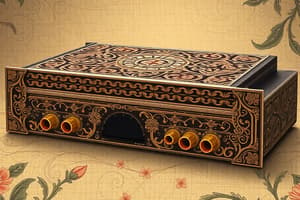Podcast
Questions and Answers
What is the primary function of a DI (Direct Injection) box?
What is the primary function of a DI (Direct Injection) box?
- To provide phantom power to condenser microphones.
- To add effects such as reverb and delay to an instrument's output.
- To convert a high impedance, instrument-level signal to a low impedance, microphone-level signal. (correct)
- To boost the instrument's signal level for louder amplification.
A DI box is only useful in studio environments, not for live sound.
A DI box is only useful in studio environments, not for live sound.
False (B)
What is the benefit of using a DI box when preserving a direct signal from an instrument?
What is the benefit of using a DI box when preserving a direct signal from an instrument?
isolation,clean signal,reduced leakage
Match the output types of a DI box with their corresponding impedance and signal level:
Match the output types of a DI box with their corresponding impedance and signal level:
What could happen if you do not use proper impedance matching when connecting an instrument to a mixer?
What could happen if you do not use proper impedance matching when connecting an instrument to a mixer?
Balanced signals are more susceptible to noise over long cable runs compared to unbalanced signals.
Balanced signals are more susceptible to noise over long cable runs compared to unbalanced signals.
Why are DI boxes useful when connecting unbalanced outputs from devices like keyboards or laptops?
Why are DI boxes useful when connecting unbalanced outputs from devices like keyboards or laptops?
Passive DI boxes can help eliminate ______ caused by ground loops.
Passive DI boxes can help eliminate ______ caused by ground loops.
What component found within a DI box allows it to change impedance?
What component found within a DI box allows it to change impedance?
Using a very long instrument cable (e.g., 50 feet) in place of a DI box will result in no noticeable signal degradation or noise.
Using a very long instrument cable (e.g., 50 feet) in place of a DI box will result in no noticeable signal degradation or noise.
Explain the difference in signal level between what an instrument outputs and what a microphone input expects.
Explain the difference in signal level between what an instrument outputs and what a microphone input expects.
Many modern audio interfaces include built-in ______ inputs to accommodate instruments directly.
Many modern audio interfaces include built-in ______ inputs to accommodate instruments directly.
Match the device with the typical signal type it outputs:
Match the device with the typical signal type it outputs:
Why is a DI box especially important if your mixer or audio interface lacks a dedicated instrument input?
Why is a DI box especially important if your mixer or audio interface lacks a dedicated instrument input?
All DI boxes require phantom power to operate correctly.
All DI boxes require phantom power to operate correctly.
A DI box helps to ______ the signal, which reduces noise over long cable distances.
A DI box helps to ______ the signal, which reduces noise over long cable distances.
Match the following devices to the reason you might use a DI box with them:
Match the following devices to the reason you might use a DI box with them:
If you connect a guitar directly into a microphone input without a DI box, what is the MOST likely problem you will encounter?
If you connect a guitar directly into a microphone input without a DI box, what is the MOST likely problem you will encounter?
In a setup where a DI box allows for both recording a clean instrument signal and sending the signal to an amplifier simultaneously, what does the 1/4" "Thru" connect to?
In a setup where a DI box allows for both recording a clean instrument signal and sending the signal to an amplifier simultaneously, what does the 1/4" "Thru" connect to?
View this video, then answer the following questions:
https://www.youtube.com/watch?v=_xybjiuD9K0 (you may need to copy and paste the link into a web browser)
Question: Did you watch the video above?
View this video, then answer the following questions: https://www.youtube.com/watch?v=_xybjiuD9K0 (you may need to copy and paste the link into a web browser) Question: Did you watch the video above?
Flashcards
DI Box
DI Box
Converts high impedance, instrument-level signals to low impedance, microphone-level balanced signals.
Common DI Box Use Case
Common DI Box Use Case
Connecting instruments like bass or electric guitar directly to a mixer or audio interface.
Impedance and Level Matching
Impedance and Level Matching
Matches instrument high impedance output to microphone low impedance input.
Instrument Inputs
Instrument Inputs
Signup and view all the flashcards
Balancing Signals
Balancing Signals
Signup and view all the flashcards
Ground Loop Elimination
Ground Loop Elimination
Signup and view all the flashcards
Study Notes
DI Box Functionality
- DI (Direct Injection) boxes convert high impedance, instrument-level signals to low impedance, microphone-level signals
- DI boxes balance the signal in the process, which subsequently optimizes it for longer cable runs
- DI boxes assure compatibility with pro audio equipment
- DI boxes are useful in both live sound and studio environments
Common Use Case
- DI boxes are used in connecting a bass guitar or electric guitar to a microphone input on a mixer or audio interface
- DI boxes preserve a direct signal, which remains unaffected by the instrument's amplifier
- DI boxes are used for re-amping or amp modeling plugins
- DI boxes provide a clean, isolated signal with leakage reduced from other instruments
Impedance and Level Matching
- Instrument pickups output a high impedance, instrument-level signal
- Microphone inputs are designed for low impedance, microphone-level signals
- A DI box acts as a transformer, converting the signal to the appropriate impedance and level
- Most DI boxes have an XLR output (low impedance, mic level) and a 1/4 inch through output (high impedance, instrument level to connect to an amplifier)
Instrument Inputs on Interfaces
- Many audio interfaces have built-in instrument inputs with impedance switching
- The difference in sound quality between using a DI box into a mic input and using an instrument input directly on the interface can be subtle, but both are typically usable
- If the interface or mixer lacks a dedicated instrument input, using a DI box becomes more crucial
- Without proper impedance matching, high frequencies can roll off, especially when the signal is saturated by amp modeling plugins
Balancing Signals
- DI boxes balance unbalanced signals from instruments
- Balanced signals can travel longer distances with less noise
- Unbalanced instrument cables longer than approximately 20 feet can pick up noise
- A DI box allows short, unbalanced connections from the instrument to the DI box and DI box to amp, then a long, balanced connection from the DI box to the mixer
- Using a long instrument cable can result in rolled-off high frequencies and increased noise compared to a balanced signal from a DI box
Other Applications
- Balancing signals from keyboards, smartphones, laptops, TVs, and other devices with unbalanced outputs for long cable runs
Ground Loop Elimination
- Passive DI boxes have no direct connection between the input and output
- Ground loops, which are caused by buzz and hum, can be eliminated by DI boxes
Studying That Suits You
Use AI to generate personalized quizzes and flashcards to suit your learning preferences.





